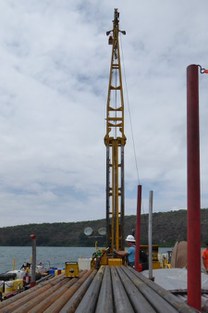Ghent University researchers expect more droughts in the Horn of Africa, as opposed to predictions of climate models
(23-08-2023) The climate in the Horn of Africa is behaving differently than expected. As it gets warmer, it gets drier, while current climate models predict a wetter climate. That situation arose some 11,700 years ago, Ghent University researchers discovered.
‘Wet gets wetter, dry gets drier’. That mantra has been used for decennia to predict how global warming will affect the hydrological cycle in different world regions. But if climate models predict that much of tropical Africa will enjoy a future with wetter weather, then why does it keep getting drier in certain parts of the African tropics, like the Horn of Africa? An international team of researchers have found a pre-historic climate tipping point that helps explain the disparity between these model predictions and the intensifying drought conditions in the Horn of Africa. Their new study was published in the scientific journal Nature on 9 August.
Moisture equals rainfall minus evaporation
Simply put, two main things make up how wet or dry an environment is: the amount of rainfall, and the amount of water that evaporates from the land and plants. In the tropics, higher temperatures typically bring along wetter weather due to stronger monsoons. At the same time, higher temperatures also cause more evaporation since in warmer air, water evaporates more easily.
And yet, recently parts of the world like the Horn of Africa have seen severe multi-year droughts with rising temperatures. A research team including lead co-authors Dirk Verschuren (Ghent University) and Allix Baxter (Utrecht University) have found an explanation for the disparity between climate model predictions and recent droughts in eastern Africa in the sediments of Lake Chala, located on the Kenya/Tanzania border near Mount Kilimanjaro.
Lake sediment cores
“We studied sediment cores taken from the bottom of the lake dating back to 75,000 years ago,” says Baxter. After five years of preparation, it took the team three months of fieldwork involving over a hundred people to install the drilling barge and recover the sediment cores. “From these sediments we were able to figure out how the lake depth and regional temperature changed through time.” How deep the lake was reflects changes in moisture balance; the amount of rainfall minus the amount of evaporation.
Climate tipping point

“We found that, during the last ice age between 75,000 and 11,700 years ago, higher temperatures in the Horn of Africa did indeed produce a wetter climate,” Verschuren explains. “But around 11,700 years ago, when the region’s temperature naturally rose by a few degrees, we saw a tipping point in which higher temperatures led to increased drought, and lower temperatures meant wetter conditions.” This fundamental change in the relationship between temperature and moisture in the Horn of Africa, has since locked this region into a dry tropical climate regime, which the researchers expect to continue as temperatures keep rising in the future.
“This finding matches with the increasing number and severity of droughts we now see happening in the Horn of Africa,” Baxter illustrates. Quite importantly for this region where most people depend on rain-fed agriculture, the new research suggests that the Horn of Africa is likely to become even drier, not wetter in the future as predicted by most climate models. “Though it’s still debated what the cause is of these recent droughts, our research provides the clue to an underlying mechanism. Our data has revealed certain processes that we hope are better incorporated in the climate models to more accurately predict long-term future climate change in this and other tropical regions.”
Microbes as indicator
How do researchers know how deep and warm a lake was thousands of years ago? The team used organic molecules that make up part of the membrane of microbes living in the lake. These microbes make slightly different molecules to change the properties of their membranes in order to better survive in warm or cold environments. This means the types of such membrane molecules found in ancient sediments can be used to reconstruct past changes in temperature.
In-depth studies of modern-day Lake Chala showed when and where in the water column these microbes live. Certain microbes live only in the oxygen-rich uppermost water layer, whereas others prefer the oxygen-poor deeper layers. Because this oxygen-poor layer of the lake becomes larger when the lake is deeper and the climate is wetter, the proportion of membrane molecules formed by each group and preserved in the sediments reveals how wet the environment used to be.
Collaboration
This publication is the result of a collaboration of researchers from Utrecht University, Ghent University, NIOZ Royal Netherlands Institute for Sea Research, the Max Planck Institute for Chemistry, the University of Nairobi, the University of Haifa, and the University of Cambridge.
Publication
Baxter, A.J., Verschuren, D., Peterse, F. et al. Reversed Holocene temperature–moisture relationship in the Horn of Africa. Nature 620, 336–343 (2023).
Contact
Prof. Dirk Verschuren
Department of Biology
0032 9 264 52 55/62
dirk.verschuren@ugent.be